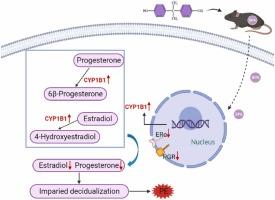暴露于双酚A危害去个体化,从而通过上调CYP1B1触发子痫前期
IF 11.3
1区 环境科学与生态学
Q1 ENGINEERING, ENVIRONMENTAL
引用次数: 0
摘要
子痫前期(PE)是一种妊娠相关疾病,对母亲和胎儿的健康构成重大威胁。以往的研究主要集中在胎盘在PE发病机制中的作用;然而,正常的脱个体化对胎盘和妊娠的后续发育至关重要。双酚A (BPA)是一种环境内分泌干扰物,常用于合成聚碳酸酯和环氧树脂。过量接触双酚a会导致严重的生殖问题。为了进一步研究BPA暴露对妊娠的影响,本研究将C57BL/6小鼠连续暴露于0或100 mg/kg的BPA中。结果,这些小鼠出现高血压和蛋白尿症状,表明PE。此外,他们的去个体化过程受损。人工诱导蜕膜的转录组测序显示,bpa处理组CYP1B1的表达显著上调。这种上调加速了雌激素和黄体酮的代谢,导致它们的水平显著下降。此外,雌激素和孕激素受体及其相关基因的表达水平显著降低。这些发现表明,BPA暴露会对去个体化和胎盘发育产生负面影响,可能导致PE的发生。本文章由计算机程序翻译,如有差异,请以英文原文为准。

Exposure to Bisphenol A jeopardizes decidualization and consequently triggers preeclampsia by up-regulating CYP1B1
Preeclampsia (PE) is a pregnancy-related disease that poses a significant threat to the health of both the mother and the fetus. Previous studies have primarily focused on the role of the placenta in PE pathogenesis; however, normal decidualization is crucial for the subsequent development of the placenta and pregnancy. Bisphenol A (BPA) is an environmental endocrine disruptor commonly used in the synthesis of polycarbonate and epoxy resins. Overexposure to BPA can result in severe reproductive issues. To further investigate the effects of BPA exposure on pregnancy, C57BL/6 mice were continuously exposed to either 0 or 100 mg/kg of BPA in this study. As a result, these mice developed symptoms of hypertension and proteinuria, indicative of PE. Additionally, their decidualization process was impaired. Transcriptome sequencing of artificially induced decidua revealed a significant upregulation in the expression of CYP1B1 within the BPA-treated group. This upregulation accelerated the metabolism of estrogen and progesterone, leading to significant decreases in their levels. Furthermore, the expression levels of estrogen and progesterone receptors and their responding genes were significantly reduced. These findings suggest that BPA exposure can negatively impact decidualization and placental development, potentially contributing to the development of PE.
求助全文
通过发布文献求助,成功后即可免费获取论文全文。
去求助
来源期刊

Journal of Hazardous Materials
工程技术-工程:环境
CiteScore
25.40
自引率
5.90%
发文量
3059
审稿时长
58 days
期刊介绍:
The Journal of Hazardous Materials serves as a global platform for promoting cutting-edge research in the field of Environmental Science and Engineering. Our publication features a wide range of articles, including full-length research papers, review articles, and perspectives, with the aim of enhancing our understanding of the dangers and risks associated with various materials concerning public health and the environment. It is important to note that the term "environmental contaminants" refers specifically to substances that pose hazardous effects through contamination, while excluding those that do not have such impacts on the environment or human health. Moreover, we emphasize the distinction between wastes and hazardous materials in order to provide further clarity on the scope of the journal. We have a keen interest in exploring specific compounds and microbial agents that have adverse effects on the environment.
 求助内容:
求助内容: 应助结果提醒方式:
应助结果提醒方式:


